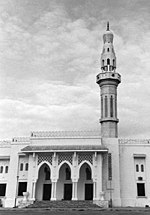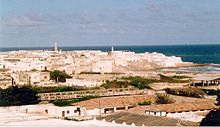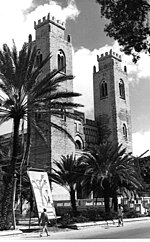Religion in Somalia
The predominant religion in Somalia is Islam,[2] with tiny minorities of Christians, traditional African religions and others.
State religion
Islam

Most residents of Somalia are Muslims,[3] of which some sources state that Sunnism is the strand practised by 99% of the population, whereof in particular the Shafi'i school of Islamic jurisprudence is practiced.[4] However, a Pew Research Center survey of its Somali-majority northwestern neighbour Djibouti reported a creed breakdown of Muslims which was reported as 77% adhering to Sunnism, 8% as non-denominational Muslim, 2% as Shia, 13% percent refusing to answer, and a further report inclusive of Somali Region stipulating 2% adherence to a minority sect (e.g. Ibadism, Quranism etc.).[5][6][7] Sufism, the mystical dimension of Islam, is also well-established, with many local jama'a (zawiya) or congregations of the various tariiqa or Sufi orders.[8] Article 3 of the Provisional Constitution of Somalia defines Islam as the state religion of the Federal Republic of Somalia, and Islamic sharia as the basic source for national legislation. It also stipulates that no law that is inconsistent with the basic tenets of Shari'a can be enacted. Article 11 guarantees equal rights and freedom from persecution for all citizens before the law regardless of religion. Additionally, Article 17 protects freedom of religion.[9]
History
Bronze age
As the Horn was located to the east of sun-worshipping Egypt, the Horn being associated with the sunrise was then referred to as God's land during the Puntite period, arguably referring to deities such as Ra. For much of the 1st millennium BC and 1st millennium AD, a predominant religion practised by proto-Somalis as well as other Cushites and Horners was Waaq religion, although in the post-classical period, various Abrahamic faiths became increasingly prevalent.[10][11]
Classical era
The native standard derivation suffixes to signify adherence to the Waaqist religion would produce Waaqnimo as the uncountable noun, and waaqyahan as the agent noun.[12] Sources differ on whether Waaqism was henotheistic or monotheistic.[13]
Many of the exact ancient practices of waaqism are to some extent speculative, however analysts have used various methods to envisage or conceptualize the ancient inferences of the religion, including explicating from the analogous Oromo concept of Waaqeffannaa which has in many ways overlaps with Waaqism. Other methods include explicating from remnant spiritual practises which are sometimes inferred to in precolonial Somali poetry dating to around the turn of the 19th century, or through the usage of retrospection via its appearance in several Somali proper nouns, such as in the title of clan names such as Jidwaaq (meaning path of Waaq), or in place names such as Caabudwaaq (meaning worship Waaq). Contemporary Somali views on the ancient religion vary from aversiveness, to a perception that its monotheistic aspects ameliorated conversions to Abrahamic religions over the course of the 1st and 2nd millennium, to an intuition that some Waaqist practises linger within Somali culture in the form of syncretism.[14]
There was a marked and pronounced difference in prehistoric forms of worship among Low-land Cushitic Horners, and that of the ancient proto-Somali Waaqists. Whereas pre-historic archeological finds such as that at Laas Geel are suggestive of panentheistic polytheism and naturalistic pantheism which included the worship of cattle, the subsequent literate period during the antiquity and the classical era wherein Waaqism became a predominant religion among the indigenous proto-Somalis appear to leave no traces of such forms of worship. As it is widely acknowledged that Abrahamic religions had reached the Horn of Africa concurrently with other parts of the world, this could suggest that Abrahamic tenets such as monotheism, non-tangible divinity, an ultimate destiny and omniscience may have influenced adaptations or configurations within Waaqism.[15][16]
Elements of Somali culture, which have been suspected of being a ligature or remnant of ancient Waaqism and overtly observed surviving into the 19th century include reverence-related aspects of qabiilism (associated with ancestor veneration), or in the South West state, former incorporations into dabshid, which used to include several practises associated with fire. However, some Somali clans more observant of mystical rites such as Madhiban are covert and secretive about their ancient Somali culture.[17] Some of the religious practises dating back to the Waaq or classical era survive into the present, including mingis, a pre-islamic demon-cleansing ritual. However, mingis-practitioners in Somalia do face security risks. In July 2020, five people were killed in the country allegedly due to their practise of mingis.[18]
Medieval era
Islam entered the region very early on, shortly after the hijra. The two-mihrab Masjid al-Qiblatayn dates to the 7th century, and is the oldest mosque in the country. In the late 9th century, Al-Yaqubi wrote that Muslims were living along the northern Somali seaboard.[19] He also mentioned that the Adal kingdom had its capital in the city,[19][20] suggesting that the Adal Sultanate with Zeila as its headquarters dates back to at least the 9th or 10th century. The city of Zeila was described as a completely Muslim city in the 14th century by Ibn Battuta.[21][22] According to I.M. Lewis, the polity was governed by local dynasties, who also ruled over the similarly-established Sultanate of Mogadishu in the Benadir region to the south.[20]

There are two theories about when Somalis began adopting Islam.[23] One states that Islam probably arrived in Somalia in the 7th-century when followers of Muhammad came over to escape persecution from the Quraysh tribe in Mecca.[23] An alternate theory states that Islam was brought to the coastal settlements of Somalia between the 7th and the 10th century by seafaring Arab and Persian merchants.[23][24] The Sunni-Shia split within Islam may have occurred before Islam became widespread among Somalis, today Sunnis constitute the overwhelming majority.[23] Somali Sufi religious orders (tariqa) – the Qadiriyya, the Ahmadiya and the Salihiyya – in the form of Muslim brotherhoods have played a major role in Somali Islam and the modern era history of Somalia.[23][25][26]
Of the three orders, the less strict Qaadiriya tariqa is the oldest, and it is the sect to which most Somalis belonged.[27] The Qaadiriya order is named after Shaikh Muhiuddin Abdul Qadir Gilani of Baghdad.[28] I. M. Lewis states that Qaadiriya has a high reputation for maintaining a higher standard of Islamic instruction than its rivals.[29]
Ahmadiyah and its sub-sect Salihiyyah preached a puritanical form of Islam,[27] and have rejected the popular Sufi practice of tawassul (visiting the tombs of saints to ask mediation). B. G. Martin states that these two orders shared some of the views of the Wahhabis of Arabia.[30] The religious differences between Qaadiriya and Salihiyya were controversial, as Salihis continued to oppose the Qadiris' practice of tawassul, and claimed the act to be invalid and improper religious activity.[30]
The Ahmadiya has the smallest number of adherents of the three orders.[25]
Qur'anic schools (also known as dugsi) remain the basic system of traditional religious instruction in Somalia. It is delivered in Arabic. They provide Islamic education for children. According to the UNICEF, the dugsi system, where the content is based on the Quran, teaches the greatest number of students and enjoys high parental support, is oftentimes the only system accessible to nomadic Somalis as compared to urban areas.[31] A study from 1993 found that "unlike in primary schools where gender disparity is enormous, around 40 per cent of Qur'anic school pupils are girls; but the teaching staff have minimum or no qualification necessary to ensure intellectual development of children." To address these concerns, the Somali government subsequently established the Ministry of Endowment and Islamic Affairs, under which Qur'anic education is now regulated.[32]
The Somali community has produced important Muslim figures over the centuries, many of whom have significantly shaped the course of Islamic learning and practice in the Horn of Africa.[33]
Minorities

Christianity
Christianity came to coastal areas of the Somalia in 7th century.[34]
In 1913, during the early part of the colonial era, there were virtually no Christians in the Somali territories, with only about 100–200 followers coming from the schools and orphanages of the few Catholic missions in the British Somaliland protectorate.[35] There were also no known Catholic missions in Italian Somaliland during the same period.[36] In the 1970s, during the reign of Somalia's then Marxist government, church-run schools were closed and missionaries sent home. There has been no archbishop in the country since 1989, and the cathedral in Mogadishu was severely damaged during the civil war.
As of 2021, there are at least some known local Christians in Somaliland.[37]
According to estimates of the Diocese of Mogadishu (the territory of which coincides with the country) there were only about 100 official Catholic practitioners in Somalia in 2004.[38]
Traditional Faith
According to the Pew Research Center, less than 0.01% of Somalia's population in 2010 were adherents of traditional or folk religions.[39] These mainly consisted of some non-Somali ethnic minority groups in the southern parts of the country, who practice animism. In the case of the Bantu, these religious traditions were inherited from their ancestors in Southeast Africa, and include the practice of possession dances and the use of magic and curses.[40] Waaqism was an ancient traditional religion practised by many Horners, in particular by Cushites. As there has not been a comprehensive survey, it is unclear to what extent Somali Waaqists exist in the contemporary period.[41]
Other
According to the Pew Research Center, less than 0.01% of Somalia's population in 2010 were adherents of Hinduism, Buddhism, or unaffiliated with any religion.[39] One correspondent has discussed how irreligiosity is an increasing phenomenon among Somalis. Although the bulk of this sentiment comes from Somalis in the diaspora, there are also many Somalis from their home country, Somalia, who discuss their disbelief in religion, although covertly. These discussions primarily revolve around the existence of God. It has been theorized that increased apostasy, irreligiosity and detachment from religion stems from misgivings and despair at the existence of radical Salafist groups such as Daa'ish and Shabab.[42][43]
Freedom of religion
The provisional constitution of Somalia provides for the right of individuals to practice their religion, makes Islam the state religion, prohibits the propagation of any religion other than Islam (although it does not explicitly ban conversion), and stipulates all laws must comply with the general principles of Muslim religious law. No exemptions from application of sharia legal principles exist for non-Muslims. The federal government of Somalia had limited ability to implement its laws beyond greater Mogadishu; most other areas of Somalia were outside its control.[44] The provisional constitution requires the president, but not other office holders, to be Muslim. There are no public places of worship for non-Muslims in the country, outside of the international airport.[44]
Due to the Somali Civil War, the enforcement of laws pertaining to religion by the various autonomous governments in the region is inconsistent. Generally, the judiciary in most areas relies on xeer (traditional and customary law), sharia, and the penal code.[44]
In 2023, the country was scored zero out of 4 for religious freedom.[45] In the same year, the country was ranked as the second worst place in the world to be a Christian, just behind North Korea.[46]
Societal attitudes
There is a strong societal pressure to adhere to Sunni traditions. Conversion from Islam to another religion has been socially unacceptable in all areas of Somalia. According to the federal Ministry of Religious Affairs, more than 99 percent of the population is Sunni Muslim. In 2022, members of other religious groups combined constitute less than 1 percent of the population and include a small Christian community, a small Sufi Muslim community, and an unknown number of Shia Muslims, as well as Hindus, Buddhists, Jews and some animists.[44]
See also
References
- ^ "Religions in Somalia | PEW-GRF". Archived from the original on 2017-02-05.
- ^ "Religions in Somalia | PEW-GRF". www.globalreligiousfutures.org. Retrieved 2020-07-26.
- ^ "Middle East Policy Council – Muslim Populations Worldwide". Mepc.org. 2005-12-01. Archived from the original on 2006-12-14. Retrieved 2010-06-27.
- ^ Oldfield, EC (1993). The Endemic Infectious Diseases of Somalia. Vol. 16. p. 133. doi:10.1093/clinids/16.supplement_3.s132. PMID 8443330.
and at least 90% are Sunni Muslims. However, deep divisions exist among competing clan-families, clans, and lineages. The history of Somalia is a long and repetitive story of conflicts
{{cite book}}:|journal=ignored (help) - ^ "Religious Identity Among Muslims". Pew Research Center's Religion & Public Life Project. 2012-08-09. Retrieved 2020-05-07.
- ^ Filesi, Teobaldo. "MOGADISCIO: TANTI SECOLI FA." Africa: Rivista trimestrale di studi e documentazione dell’Istituto italiano per l’Africa e l’Oriente 51.2 (1996): 263-272.
- ^ Abdullahi, Mohamed Diriye (2001). Culture and customs of Somalia. Greenwood. pp. 1. ISBN 978-0-313-31333-2.
- ^ I. M. Lewis, Saints and Somalis: popular Islam in a clan-based society, (The Red Sea Press: 1998), pp. 8–9.
- ^ "The Federal Republic of Somalia - Provisional Constitution". Archived from the original on 2 April 2015. Retrieved 7 January 2015.
- ^ Ta’a, Tesema. "Religious beliefs among the Oromo: Waaqeffannaa, Christianity and Islam in the context of ethnic identity, citizenship and integration." Ethiopian Journal of the Social Sciences and Humanities 8.1 (2012): 87-111.
- ^ Kirwan, Laurence Patrick. "The Christian topography and the Kingdom of Axum." Geographical Journal (1972): 166-177.
- ^ Cohen, David, Marie-Claude Simeone-Senelle, and Martine Vanhove. "The grammaticalization of ‘say’and ‘do’: An areal phenomenon in East Africa." Reported discourse: A meeting ground for different linguistic domains. Benjamins: Amsterdam/Philadelphia, 2002.
- ^ Said, M., and Shidad Hussein. "1) Previously-noted Archeo-cultural Connections." (2015).
- ^ Aram, Ben I. "Somalia's Judeao-Christian heritage: a preliminary survey." Africa Journal of Evangelical Theology 22.2 (2003): 3-28.
- ^ Said, M., and Shidad Hussein, Previously-noted Archeo-cultural Connections. (2015).
- ^ Rodríguez, Jorge de Torres. "Against All Odds: The History of Archaeological Research in Somaliland and Somalia." Northeast African Studies 18.1-2 (2018): 271-310.
- ^ Behr, Agnes Wanjiru. "IDENTITY AND BODY BORDERS: THE PERCEPTION OF THE KENYA SOMALIA BORDER." American Journal of International Relations 3.1 (2018): 1-10.
- ^ "Scores killed in mass shooting in Mogadishu".
- ^ a b Encyclopedia Americana, Volume 25. Americana Corporation. 1965. p. 255.
- ^ a b Lewis, I.M. (1955). Peoples of the Horn of Africa: Somali, Afar and Saho. International African Institute. p. 140.
- ^ Nour, Tanq Mohamed. "Ottoman Efforts to Protect Somalia from European Powers." Proceedings of the International Symposium on Islamic Civilisation in Eastern Africa: Kampala, Uganda, 15–17 December 2003. No. 13. Research Centre for Islamic History, Art and Culture, 2006.
- ^ Briggs, Phillip (2012). Somaliland. Bradt Travel Guides. p. 7. ISBN 978-1841623719.
- ^ a b c d e "A Country Study: Somalia from The Library of Congress". Lcweb2.loc.gov. pp. 96–98. Retrieved 2011-04-27.
- ^ Ira M. Lapidus (2014). A History of Islamic Societies. Cambridge University Press. pp. 480–481. ISBN 978-1-139-99150-6.
- ^ a b I. M. Lewis (1998). Saints and Somalis: Popular Islam in a Clan-based Society. The Red Sea Press. pp. 11–16. ISBN 978-1-56902-103-3.
- ^ Robert L. Hess (1964). "The 'Mad Mullah' and Northern Somalia". The Journal of African History. 5 (3): 415–433. doi:10.1017/s0021853700005107. JSTOR 179976.
- ^ a b Hess, Robert L. (1964). "The 'Mad Mullah' and Northern Somalia". The Journal of African History. 5 (3): 415–433. doi:10.1017/s0021853700005107. JSTOR 179976.
- ^ Hanif, N. (2000). Biographical Encyclopaedia of Sufis: South Asia. Sarup & Sons. ISBN 9788176250870.
- ^ Lewis, I. M. (1998). Saints and Somalis: Popular Islam in a Clan-based Society. The Red Sea Press. ISBN 9781569021033.
- ^ a b Martin, B. G. (2003-02-13). Muslim Brotherhoods in Nineteenth-Century Africa. Cambridge University Press. p. 161. ISBN 9780521534512.
- ^ pages The Integrated Quranic Schools Pilot Project: The Strategic Partnership for Recovery and Development of Education in Somalia, United Nations Children Funds, UNICEF Somalia Support Centre (2011), 6-10
- ^ "Koranic School Project" (PDF).
- ^ Mukhtar, Mohamed Haji (1987). "Arabic Sources on Somalia". History in Africa. 14: 141–172. doi:10.2307/3171836. ISSN 0361-5413.
- ^ Aweis A Ali (May 2021). "A Brief History of Christianity in the Somali Peninsula" – via ResearchGate.
- ^ Charles George Herbermann, The Catholic encyclopedia: an international work of reference on the constitution, doctrine, discipline, and history of the Catholic church, Volume 14, (Robert Appleton company: 1913), p. 139.
- ^ Charles Henry Robinson, History of Christian Missions, (READ BOOKS: 2007), p. 356.
- ^ "Somaliland Christians released after offences-against-Islam charges dismissed". 8 June 2021.
- ^ "Diocese of Mogadiscio". Catholic-Hierarchy.org. David M. Cheney. Retrieved 23 January 2015.
- ^ a b "The Global Religious Landscape, Religious groups 2010" (PDF). Pew Research Center. Archived from the original (PDF) on March 9, 2013. Retrieved 27 December 2013.
- ^ "Somali Bantu – Religious Life". Cal.org. Archived from the original on November 1, 2011. Retrieved 10 January 2015.
- ^ Mire, Sada. "Wagar, fertility and phallic stelae: Cushitic sky-god belief and the site of Saint Aw-Barkhadle, Somaliland." African Archaeological Review 32.1 (2015): 93-109.
- ^ "Islam, modernity and Somali youths". 7 September 2019.
- ^ Elfversson, Emma. "The political conditions for local peacemaking: A comparative study of communal conflict resolution in Kenya." Comparative Political Studies 52.13-14 (2019): 2061-2096.
- ^ a b c d US State Dept 2022 International Religious Freedom Report for Somalia
- ^ Freedom House website, retrieved 2023-08-08
- ^ Open Doors website, retrieved 2023-08-08
